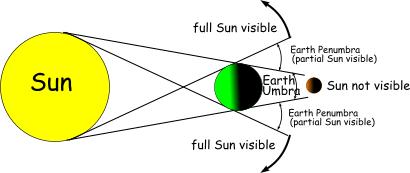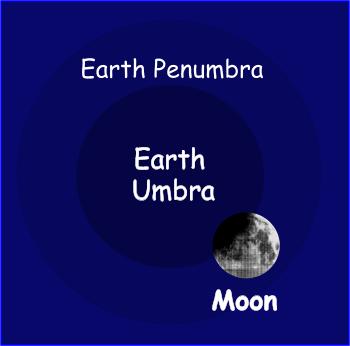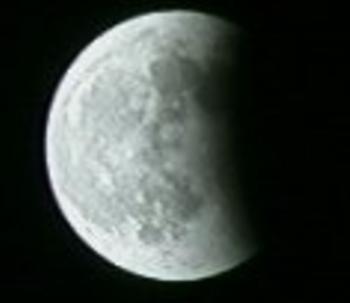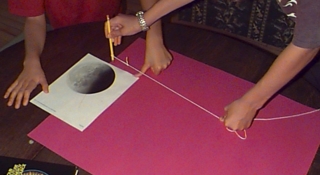Determining the Size of the Moon |
|||
|
NOTE: It is important to distinguish between the Earth’s shadow on the Moon during an eclipse, and the usual phases of the Moon which occur each month. |
|||

Transparency Master |
On average the Moon is eclipsed by the Earth about twice each year.
During a Lunar eclipse the Moon’s orbital path carries it through the Earth’s shadow as illustrated in the diagram to the left. The Earth’s shadow is divided into two sections, the penumbra from which a portion of the Sun could be seen, (if you were on the Moon), and the umbra, wherein the Sun is totally eclipsed by the Earth. The diameter of the Earth’s Umbra, (at the Moon’s distance), is almost exactly the same as the Earth’s diameter, owing to the fact that the Sun is very far away from the Earth. This fact is not apparent in the diagram to the left because the Sun has been drawn very close the Earth; the effects of geometry in this case making the Earth’s Umbra appear unnaturally small. |
||

Transparency Master |
As seen from space, the Earth’s shadow would appear as illustrated to the left.
Of course, against the dark night time sky the Earth’s shadow cannot be seen unless something really big happens to pass through it…such as the Moon. When the Moon is eclipsed by the Earth we get a chance to see how big the Earth’s shadow really is…much bigger than the Moon. But how much bigger? |
||

Transparency Master #1Transparency Master #2 |
The photograph to the left shows the Moon in partial umbral eclipse. The black section of the Moon is a section of the Earth’s shadow.
ProcedureUsing a printed copy of this image, or a printed copy of the larger images provided as Transparency Master #1
|
||
| ratio = | Moon’s image diameter (cm) Earth’s shadow diameter (cm) |
|---|
gives the relative
size of the Moon compared to the Earth.
Calculate the Moon’s diameter, in kilometres, and multiply this ratio by the Earth’s actual diameter (in km)
